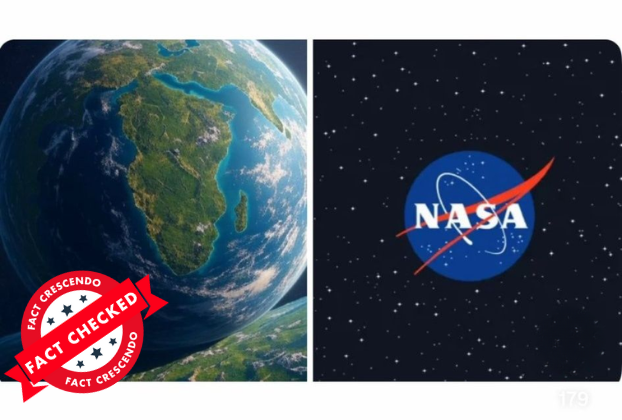A flurry of sensational headlines and viral posts has stirred public curiosity, claiming that NASA has discovered a “Super Earth” planet sending mysterious signals from 154 light-years away. However, the viral claim is misleading.
Social Media Claim
Multiple social media users has shared posts with the claim that NASA has discovered a “Super Earth” planet that is emitting strange or mysterious signals. The claim has been widely shared online on Facebook, Instagram and X.
Fact-Check
What NASA Actually Found
NASA’s Transiting Exoplanet Survey Satellite (TESS) identified TOI-1846 b, an exoplanet located approximately 154 light-years away in the constellation Lyra. It is referred to as a “Super Earth,” a category used for planets larger than Earth but smaller than Neptune.
TOI-1846 b is roughly twice Earth’s diameter and about four times as massive. It orbits a red dwarf star and completes a full revolution around its star every ~3.9 Earth days, placing it in extremely close proximity to its sun. Due to this closeness, the surface temperature is estimated to be around 300°C (600°F), far too hot to support life. (Sources: Hindustan Times, GB News)
What Are the “Mysterious Signals”?
The “signals” mentioned in these headlines refer to periodic dimming patterns in the star’s brightness. These light variations are observed when the planet passes in front of its host star, what astronomers call the transit detection method.
The transit method is a standard technique astronomers use to identify exoplanets. The resulting light curve displays consistent, mathematically predictable patterns that provide information about the planet’s orbital characteristics. In the case of TOI-1846 b, these observations yield data about its size and orbit. (Source)
NASA has found no radio transmissions, digital codes, or technological signatures from TOI-1846 b. The agency has not issued any statements suggesting intelligent sources. The data collected aligns perfectly with standard astrophysical models for exoplanet detection.
The misunderstanding stems from terminology. In astronomical contexts, “signal” refers to measurable data, specifically the periodic dimming patterns observed when a planet transits its star. These light variations represent a fundamental detection method responsible for identifying the majority of the 5,000+ confirmed exoplanets in our catalog. (Sources: Hypefresh, Newsbytes)
Why This Planet Is Called “Super Earth”
TOI-1846 b is classified as a “Super Earth,” a term referring to its size category, larger than Earth but smaller than Neptune. This classification is based solely on physical dimensions and does not indicate habitability or Earth-like conditions.
The planet has a surface temperature of approximately 300°C (600°F) due to its close proximity to its star, making it unsuitable for life as we understand it.
The scientific significance of TOI-1846 b stems from several factors:
- It occupies the “radius gap”, a statistical underrepresentation in the size distribution of known exoplanets, providing data for planetary formation theories.
- Research indicates a probable rocky composition with potential subsurface water, though not surface water.
- It represents a planetary classification absent from our solar system, contributing to our understanding of cosmic diversity.
TOI-1846 b contributes to exoplanetary science despite its differences from Earth and its inhospitable environment.
(Sources: NASA Science, Earth.com, Astrobiology.com)
Conclusion
The viral claim that NASA discovered a “Super Earth” sending strange or mysterious signals is misleading. NASA did discover TOI-1846 b, a Super Earth orbiting a red dwarf 154 light-years away, but the so-called “signals” are not unknown or technological; they are simply standard light dips caused by planetary transits. There is no indication of extraterrestrial activity, radio signals, or unexplained phenomena associated with this discovery.

Title:Is NASA’s “Super Earth” Discovery Emitting Mysterious Signals?
Fact Check By: Cielito WangResult: False






